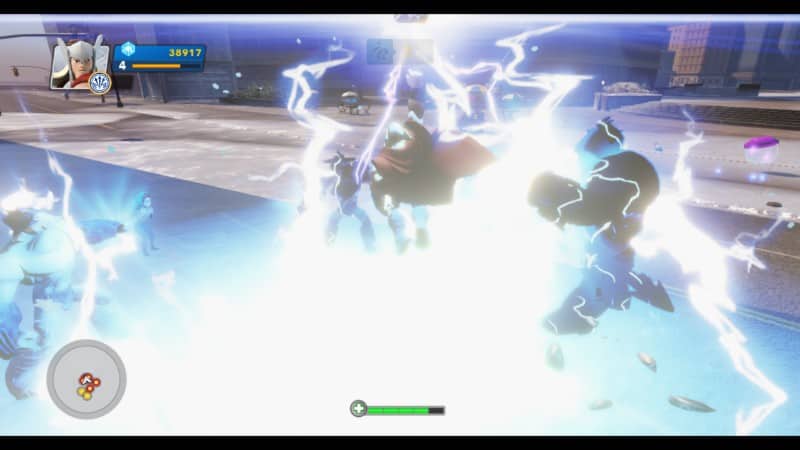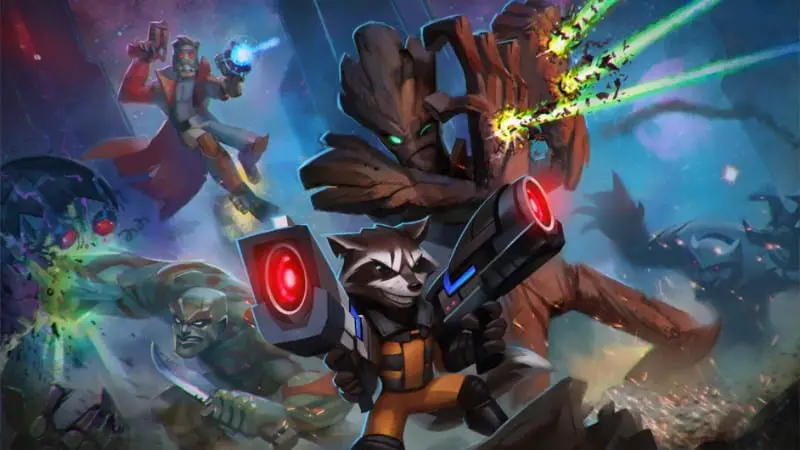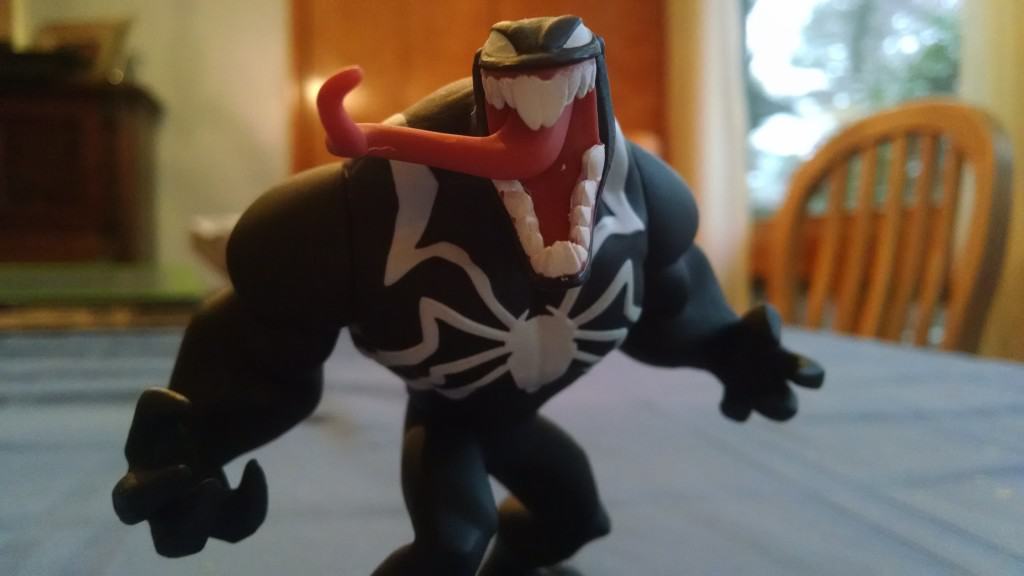Nintendo may have stolen the show from the Skylanders series with their massive amiibo sales and limited functionality in their first-party games but it’s another collection-based series, Disney Infinity, that has once again created what feels a real, fully-fledged game based off of those little collectible figures that everyone either loves or loves to hate. With Disney Infinity Marvel Super Heroes (2.0 Edition) developer Avalanche Software has improved tremendously over the series’ first entry and made a game that, while short, is full of things to do and fun to be had outside of just collecting the physical figures.
[mks_pullquote align=”left” width=”350″ size=”14″ bg_color=”#dd3333″ txt_color=”#ffffff”]Genre: Action-adventure
Publishers: Disney Interactive Studios, Bandai Namco Games, Microsoft Studios (PC, Xbox 360, Xbox One)
Developer: Avalanche Software
Platforms: PlayStation 3, PlayStation 4, Wii U, Xbox 360, Xbox One, Microsoft, PC
Release Date: September 23, 2014[/mks_pullquote] Disney Infinity: Marvel Super Heroes uses the wealth of established Marvel worlds to create some pretty satisfying short stories based around everyone’s favorite heroes, with original writing coming from famed Marvel writer Brian Michael Bendis. Nothing is all that deep or complicated of course, as the game is still aimed pretty heavily at kids, but the over-arcing stories in each play set fit well with the comics they are based off of. For the most part, you are not going to miss a whole lot if you only pay attention to the most important instructions as to what you are supposed to do, but you may miss out on some genuinely funny character moments.
Those individual characters are boiled down to their most basic parts and one liners, but mostly kept quiet so that they don’t get grating with their constant quips in battle. Anyone who has played a third-party action game with “witty” heroes knows just now annoying their non-stop one liners can be, but even Spider-Man keeps them under control within his playset. The characters you play as aren’t emphasized very heavily, outside of opening cinematics for each playset. Instead, it’s the supporting cast of each playset that provides the game its personality. For the most part they work well. Again, they are the most simplistic version of their comic book or movie counter-parts, but they move the stories along and their lines provide some nice jokes along the way.
Gameplay basics in Disney Infinity 2.0 are almost identical to the first game. Characters still move like they’re in mud, and combat is simplified to one or two buttons for the most part. Where it differs however, is in the depth surrounding the button-mashing combat. For on, this time around characters are given a special move. I haven’t played with every single character, but the near dozen that I did play around with all had a special move that feels true to their character. Spider-Man leaps into the air and shoots webs at all his enemies, Nova lifts enemies into the air and blasts them away, and so on. They’re all basically the same effect in the end, either a big powerful sweep move or summoning kind of creature or turret to aid you, but they’re all just unique enough that it’s fun to unlock them for each character and see how they work. Not to mention that hitting a bunch of enemies at once with a big attack is always satisfying.

Disney Infinity 2.0 still lacks any lasting challenge similar to its predecessor, but there are many short bursts that were downright difficult. The end of the Guardians of the Galaxy playset is one in particular that I had to retry more times than I’m proud to admit. Death has a slightly higher consequence as well – if a character dies you either need to put a new character in the game, or go back to a check point.
In the three playsets I own – Guardians of the Galaxy, Spider-Man, and of course The Avengers – the general gameplay seems to finally know what it wants to be. Disney Infinity 2.0 takes the series all-in on the collect-a-thon mentality of third-person platformers. It is no longer tied so strictly to the “playing in a real toybox” mentality that dragged the first game down so hard. Almost every character has a way to get around quickly, and lend themselves well to flying around collecting things then dropping in and punching some baddies with the X button until they die. Vehicles are available for other characters who can’t fly, or for players who wish to shoot things while riding a motorized hoverbike.
Missions are usually just simple “go here fetch that” or “go here kill/destroy that,” but the game focuses pretty heavily on the fun combat, so it never feels like the drag it did in the first Disney Infinity. Fighting through waves of symbiote clones is much more fun than toilet papering a statue.
While the story leads you in linear directions, you are mostly free to roam around and collect whatever you want scattered around New York and Knowhere between missions or after you complete the main storyline. Unlockable boxes are also no longer limited to a specific character, but a specific type of character. Instead of having to, say, buy Iron Man to get an unlockable that is high in the air, you instead just need a flying type character such as Nova. It removes a real slimy aspect of the collectible genre, as you can unlock almost everything with just the default characters and maybe one or two additions. As far as I can tell, nothing seems to be explicitly behind a paywall besides additional playsets and parts to use in the Toy Box.
Outside of additional things to use in the Toy Box, unlockables are mostly just concept art. Call it another side-effect of having the established world of Marvel at its disposal, but that concept art is almost all great, or at least interesting to see. Not something a lot of people will care about, though, so collecting mostly comes down to the fun of hunting down the boxes in the relatively large environments.

The main draw for the majority players (and the only thing left to do after completing the short playsets) is the Toy Box. There are certainly a lot of improvements to the mode both in and out of gameplay itself. For starters, finding, downloading, and playing on featured playsets is much more streamlined and less of a headache. These pre-built boxes can be downloaded with a single button instead of having to enter the menu, download it, then return to the list of boxes at the very top of the list. There are also now several more options for how to find a map. Developer Picks, Most Liked, Most Downloaded, Newest, Trending, and more are all ways you can now find pre-built maps to play on if you’re like me and a total failure at making anything worth playing. The creativity of the Disney Infinity audience continues to be superb, and it’s always fun seeing how they are able to use the restrictions of the game’s Toy Box tools and still make extremely well-done recreations of famous scenes or brand new adventures.
As far as actually making your custom toy boxes goes, that process is a major improvement over the first Disney Infinity as well. There is no longer a 5-second pause when switching between character and spark modes, and sorting through the items available to you finally utilizes the GamePad in a way that makes sense. On top of that, the thousands of items you can collect and use are now categorized in several clever ways. Not only just the type that they are (terrain, vehicles, enemies, etc), but also the type of project you might be working on.
It’s almost cheating to have such well-designed characters to build off of for the figures in Disney Infinity 2.0, but they look amazing regardless. Not quite as detailed as Nintendo’s amiibo line, but still look very much like their comic book-equivalent heroes and are brimming with personality. The models for Disney Infinity are always kept purposefully simplistic so it translates well into the game, but they have a lot of nice touches and feel very solid. Every character is attached to their base in clever ways, instead of just clear plastic “ice” around their feet (*cough* amiibo *cough*). Venom in particular is just an amazing figure, and while I don’t even use him much in the game, I don’t regret purchasing any of them even just as collectibles.

Rating Disney Infinity 2.0 solely as an improvement over the series’ first game, it’d be a six out of five. I would break the rating scale just to rank it that highly, it’s that much of a dramatic improvement. Where Disney Infinity felt like a baby’s first platformer and a cheap licensed cash-grab, Disney Infinity 2.0 feels like a more mature and much more polished experienced, especially in the playsets. As a game on it’s own, it still lacks in a lot of combat depth, and the game gets out control more often than it should – even in a 3D platformer. But it is an absolutely solid game to play with your kids, or to play if you’re a kid or Marvel fan at heart. Four
Last Updated on November 27, 2018.









